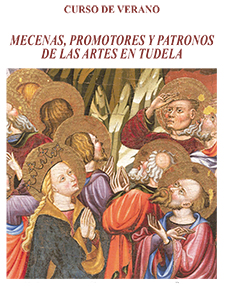PATRONS, PROMOTERS AND PATRONS OF THE ARTS IN TUDELA
26 August 2014
Patrons and Patronages in the Collegiate Church
Mrs. Mª Josefa Tarifa Castilla. University of Zaragoza
visit One of the sessions of the summer course consisted of a guided tour of the cathedral of Tudela by Mª Josefa Tarifa Castilla, professor of department of Art History at the University of Zaragoza. A Romanesque temple that was initially founded as a collegiate church dedicated to St. Mary, started around 1168 by the space of the head, concluding in the area of the feet in the last third of the thirteenth century. The dependencies of the cloister were initially occupied by the canons who lived in community according to the Rule of St. Augustine, until they were secularized in 1238, passing the collegiate church to be governed by deans, dependent from the point of view of ecclesiastical jurisdiction of the bishopric of Tarazona, until in 1783 the bishopric of Tudela was created.
The collegiate church of Santa María de Tudela was explained and analyzed as a complex, plural phenomenon, in which throughout the centuries there were quotation different personalities, civil and religious institutions, from the chapter to the city council, guilds, devotional and professional brotherhoods, families, individuals, that is, different types of patrons who in turn promoted and maintained the worship of different patrons, with rights and obligations. Devotions that had an external manifestation through the promotion of chapels, which were embellished with altarpieces, paintings, sculptures, grilles, sepulchres, etc., mostly emblazoned, accompanied by the coat of arms of that institution or personage who promoted and financed them, with a desire to report.
One of the great promoters of art in the collegiate church was undoubtedly the collegiate chapter, which commissioned for this temple one of the great artistic jewels that it houses in its interior, the Gothic altarpiece that presides over the presbytery, undertaken by the painters Pedro Díaz de Oviedo and Diego del Águila (1487-1494). The collegiate chapter was also responsible for the construction of the sacristy in the 17th century, remodeled in the 18th century according to neoclassical taste, decorated with a series of portraits of important men who had supported the cathedral thesis , by the painters Alejandro Carnicero and Diego Díaz del Valle. They also financed the erection of the conference room chapter house, adorned with the cycle of paintings commissioned to Vicente Berdusán dedicated to the life of the Virgin (1669-1671).
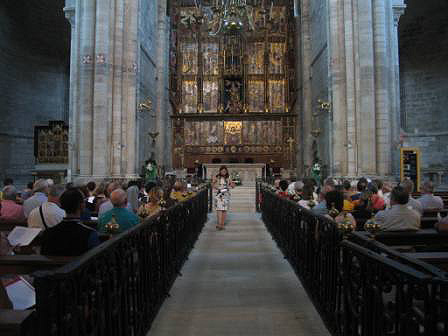
The main altarpiece of the Collegiate Church of Tudela was undertaken by Pedro Díaz de Oviedo and Diego del Águila at the end of the 15th century.
Some of the members of the collegiate chapter also promoted works in a particular way, highlighting in the sixteenth century the figure of the dean Pedro Villálón de Calcena (1513-1538), a relative of Pope Julius II, manager of the reforms undertaken in the first third of the fifteenth century in the deanery palace, as well as the impulse of the execution of the choir stalls, undertaken by the French master Esteban de Obray.
In addition to the embellishment of the temple through the endowment of a rich decoration, another of the most important works of promotion that were carried out in the same, was the acquisition of chapels of board of trustees, normally with funerary character. Example A in this regard are the different chapels located in the space of the chancel, such as that of Nuestra Señora de la Esperanza, where the Chancellor Francisco de Villaespesa and his wife received their eternal rest, in a sepulcher made by members of the workshop of Jehan de Lome (ca. 1420), presided over by a Gothic altarpiece painted by Bonanat Zahórtiga (1412) and Closed by an iron grille of the XV century. The adjoining chapel of San Juan Evangelista, in which the Dean Sancho Sanchiz de Oteiza had his tomb placed, also from the Lome workshop (ca. 1418), was under board of trustees of the Eza family in the 16th century, while the chapel of San Juan Bautista, today San Joaquín, belonged in that century to the Sanz de Berrozpe family. The Renaissance also left its mark on the chapel of San Martín, acquired by Martín de Mezquita, treasurer of the cathedral of Tarazona in 1570, which he endowed with a Mannerist altarpiece made by Bernal del Fuego and Pedro Pertús the young (1577-18), leaving the space Closed by a door contracted by Hernán de Ávila and his eponymous son in 1576.
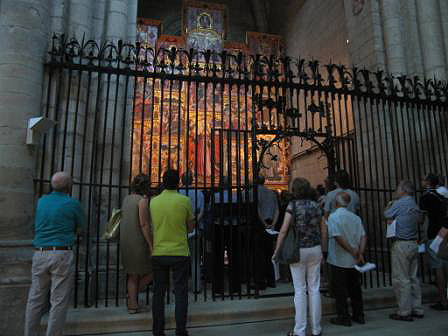
A moment of the visit guided tour of the Nuestra Señora de la Esperanza Chapel.
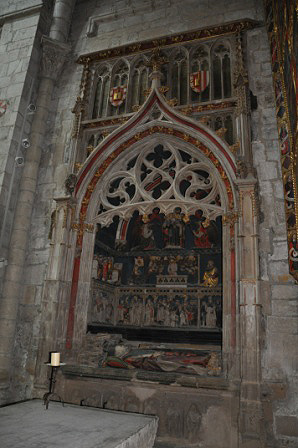
Sepulchre of Chancellor Francisco Villaespesa and his wife in the chapel of Nuestra Señora de la Esperanza (c. 1420)
(Photo: M.J. Tarifa)
Other chapels of board of trustees existing in the temple are the current penitential chapel, erected in the 16th century by Manuel Romanos under the title of San Agustín, being later dedicated to San Jerónimo, San Carlos Borromeo and the Santo Cristo de la Cama; that of San Pedro, erected by the brother of the deán, Bartolomé de Villalón (1545); or some of those that occupy the space of the trascoro, such as that of Santo Tomás de Villanueva, acquired by the canon treasurer Agustín de Baquedano, for which he commissioned a baroque altarpiece presided over by the canvas of the patron saint, by the painter Berdusán (1671). On the other hand, the present chapel of the Dolorosa belonged since the 16th century to the Egüés family's board of trustees , under the ownership of the Visitación de Santa Isabel, formerly of the Transfiguration, whose members endowed it in the 17th century with a Baroque altarpiece made by Francisco Gurrea and Sebastián de Sola in 1654, which is of singular importance in the regional altarpiece for presenting the first Solomonic columns preserved in an altarpiece in all Navarre. This space is still today Closed by a baroque grille made in 1783 by order of Ana de Egüés, Marquise of Camponuevo and patron saint of the chapel.
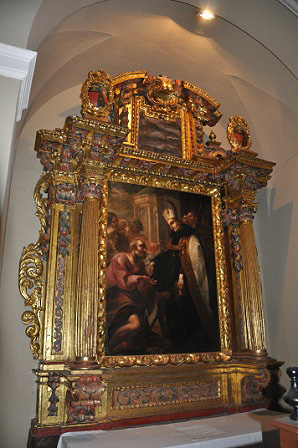
Altarpiece of Santo Tomas de Villanueva, commissioned by the canon Agustín de Baquedano and presided by the canvas of Vicente Berdusán (1671).
(Photo: M.J. Tarifa)
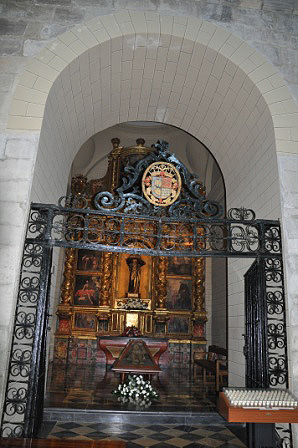
Chapel of the Egüés family, whose emblem was placed on the grille and the altarpiece.
(Photo: M.J. Tarifa)
PROGRAM
Tuesday, 26th August
Three exceptional altarpieces for three promoters
Ms. Mercedes Jover Hernando. Museum of Navarre
The great patrons of the Renaissance, a mirror of humanism
María Concepción García Gainza. Chair of Navarrese Heritage and Art
Wednesday, 27th August
Around the patron saints
D. Ricardo Fernández Gracia
Chair of Navarrese Heritage and Art
Patrons and patrons of Tudela silverware
D. Ignacio Miguéliz Valcarlos
UNED Pamplona
Patrons and Patronages in the Collegiate ( visit guidada)
Ms. María Josefa Tarifa Castilla. University of Zaragoza
Thursday, 28th August
Town planning and civil architecture
D. Carlos Carrasco Navarro. Doctor in History of Art
The great men of the Enlightenment
D. Pablo Guijarro Salvador. Chair of Navarrese Heritage and Art.
Monarchy, patrons and nuns in the Company of Mary ( visit guided)
D. Ricardo Fernández Gracia
Chair of Navarrese Heritage and Art

